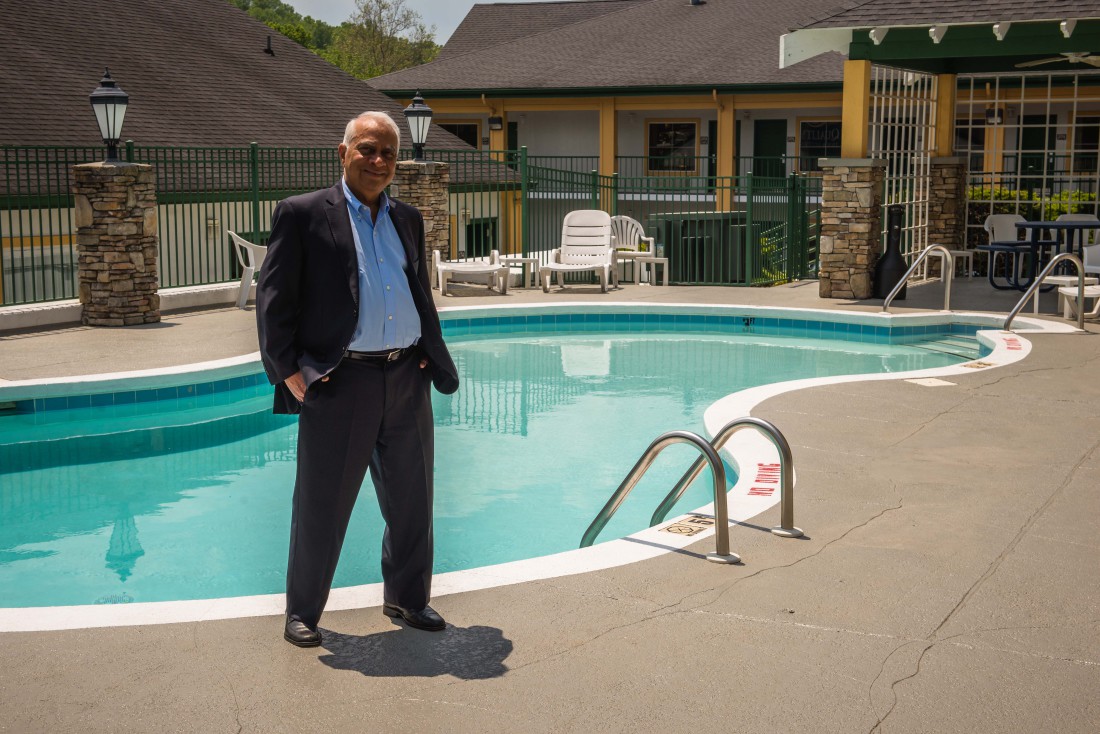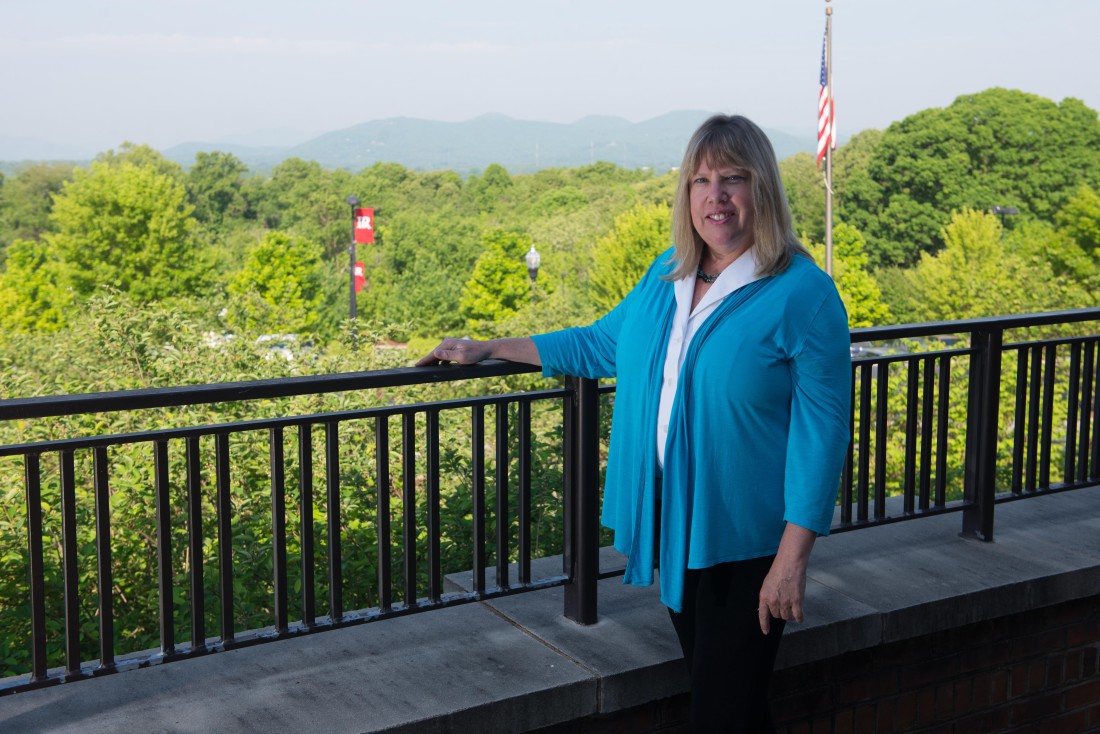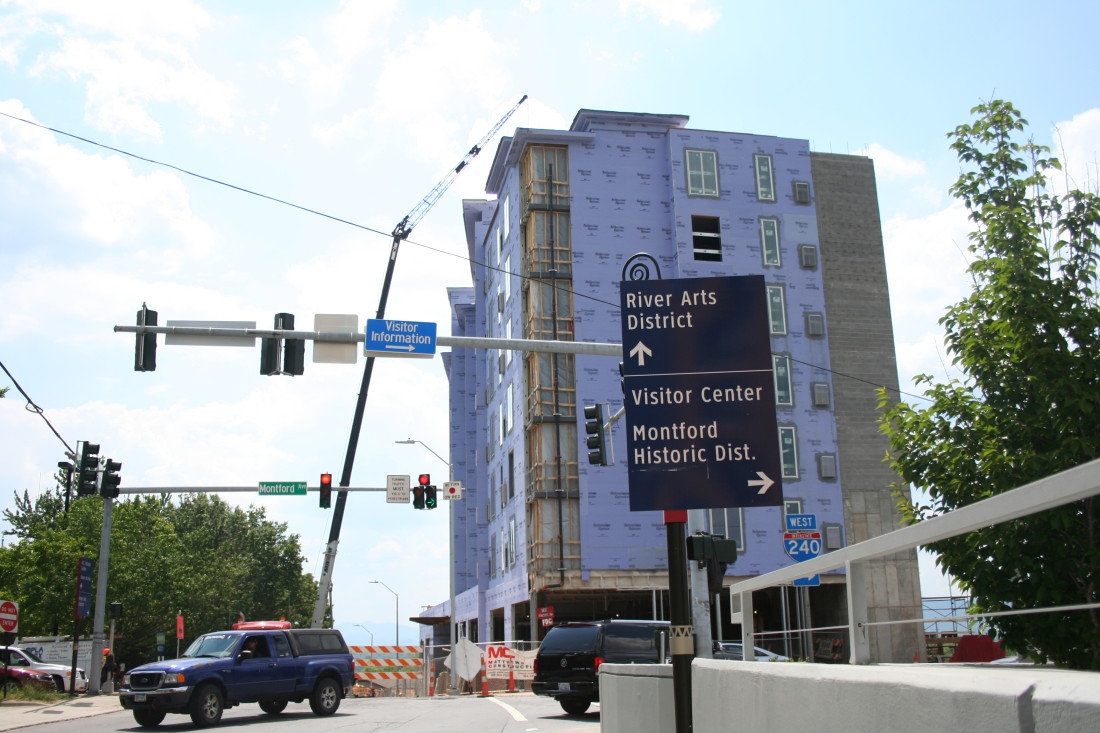A wad of money from Charlotte strolls over to Asheville. After taking a quick look around, it parks itself in the center of downtown, then puffs up and bursts apart, sending greenbacks fluttering everywhere.
Some of that money lands in restaurants; some goes to experiences like guided tours and outdoor excursions. A few bills drift over to a local retail outlet, exchanged for a coffee mug or hand-woven bag.
The owners of those businesses then take their share of the money down to the grocery store to buy food. They also use it to pay their employees, who might buy food, a new coat or even a TV. The beneficiaries of all those transactions do the same, and around and around it goes.
From a conventional economic perspective, that is tourism in a nutshell: money coming from outside the city and spreading itself around. Asheville is the “product,” tourists are the customers, and other areas are also jockeying for those dollars.
“These are our competitors,” says Bob Patel, leaning over a sheet of tourism statistics for nearby destinations. “Asheville is competing with other cities.”

Originally from India, Patel now chairs the Buncombe County Tourism Development Authority’s board; he also owns four hotels in Asheville. He acquired the first one in 1982, before downtown revitalization. He’d previously owned a hotel in Pensacola, Florida, and before that, he worked as a structural engineer.
Patel points to Charleston’s entry on the sheet in front of him, saying his goal is to beat them. And according to the data he’s assembled, we’re close, trailing slightly in hotel room occupancy rate and actually ahead in the average price of those rooms.
The way he sees it, each visitor coming here represents money leaving some other city’s economy and slipping into Asheville’s, and vice versa.
“So we’re trying to steal the other city’s lunch here,” says Patel. “A pie is only so big.”
To him, the more tourists the better. So from that perspective, the fact that there are five hotels under construction around town and at least seven more being considered should be good news for all. More lodging, the thinking goes, equals more tourists, which equals more money — assuming, that is, that those hotel rooms are occupied.
But Tom Tveidt, an independent economic analyst and former director of research for the Asheville Area Chamber of Commerce, says it’s hard to predict how this round of substantial investment will fare.
“A concern whenever there’s a big burst in any industry is, ‘How sustainable is this?’” he notes, adding, “Obviously, no one knows.”
And downtown business owner Franzi Charen, who’s also the director of the Asheville Grown Business Alliance, worries that the increased demand for goods and services stemming from those additional bodies on the street might attract more corporate chains that could drive out local indie businesses.
Interdependence
Asheville currently has about 7,200 hotel and motel rooms that are subject to the 4 percent occupancy tax levied on room sales. And if all of those current hotel projects came to fruition (which is by no means guaranteed), it would add at least 1,115 more, boosting the total number by 15 to 20 percent, notes Patel. Demand, meanwhile, is increasing by about 4 percent per year. So if all of them popped up out of the ground fully formed today and demand continued to grow at the same rate, it could take four or five years for the scales to re-balance.
Effective marketing, however, could potentially speed things up, and that’s where the Convention and Visitors Bureau comes in. While hotels, restaurants and other services advertise themselves individually, the bureau promotes Asheville as a whole.
Marla Tambellini, the organization’s deputy director and vice president of marketing, says Asheville has a brand, and her organization is charged with crafting and promoting that brand. To do this, the bureau, an arm of the Chamber of Commerce, uses various tools, including marketing strategies, a geographic focus, a primary target audience (experiential travelers ages 25-54), media and communications strategies, extensive data analysis, and actively pursuing conferences and business conventions.

The bureau’s marketing strategy for 2014-15 plays up the range of experiences available here, rather than focusing on any single one.
“What we’ve found is it’s really the collection of our assets that’s appealing to people,” Tambellini explains. “It’s the mountains, it’s food, it’s music, it’s Biltmore.”
Downtown Asheville, she notes, has gradually become a significant part of that array as well, as local restaurants and other businesses have flourished to the point that some now qualify as attractions themselves.
And it’s a symbiotic relationship, notes Charen.
“We probably have 90 percent walk-by traffic,” she says. “They just pop their heads in and they buy something. We’re very dependent on the tourism industry. We don’t try to build our business or gear it that way, but because of our location downtown, because downtown is such a tourist attraction, it’s what ends up happening.”
In 2012, for example, 3.1 million overnight visitors to Buncombe County spent an average of $129 per person per day, more than half of it on food and beverages or retail shopping, according to an economic impact analysis by Tourism Economics, a global consulting firm.
Still, Charen fears that too many visitors might end up undermining the very culture that drew them here to begin with. But she believes that such measures as incentives and subsidies for independent businesses, and limits on things like store size, could help prevent this. Charen also questions the wisdom of investing too much in an industry that’s prone to significant peaks and valleys.

Self-sufficient
Tveidt, though, says the local tourism industry isn’t really all that unstable. Recalling the concern in the wake of 9/11 that tourism would drop off, he says, “The irony of it is, we actually did better after 9/11, because people were afraid to get on planes. This is a drive market.”
In addition, he maintains, the city’s investment in the tourism industry is not all that significant: It’s the hotel investors who are taking the risk. Asheville’s appeal, notes Tveidt, isn’t based on some big theme park or natural wonder that the city needs to sink money into. The things that draw visitors here are either inherent, such as the mountains and the heritage, or develop on their own in the natural course of things, as Asheville’s culture and local businesses have.
“It’s kind of self-sufficient, and it’s a lot of small businesses,” he says. “So it’s dynamic, and it’s able to change direction pretty easily.”
Besides, the money used to market and develop tourism comes directly out of tourism revenue, in the form of the occupancy tax. And the state legislation that enacted the tax spells out how that money can be spent: Three-quarters is used for marketing, and the rest goes to the Tourism Product Development Fund.
Businesses can apply for grants and loans from this fund for projects that have the potential to attract more overnight visitors to the area. Highland Brewing Co., RiverLink and the Asheville Art Museum have all received grants for projects that are set to break ground this year. Between 2010 and 2013, the U.S. Cellular Center received a series of grants totaling over $4 million to renovate the convention space in the former Asheville Civic Center. The Riverfront Destination Development Project, meanwhile, was awarded $1.8 million.
“It’s one of the few industries where the things they do for their customers benefit the residents as well,” says Tveidt. “Obviously, they want clean streets, they want safe streets, they want lots of nice restaurants, they want diverse entertainment. … They’re not doing it for us, but we can profit from it as well.”
Darwinian evolution
Tourism, Tveidt maintains, creates a dynamic economy that can quickly respond to market conditions: A trendy new restaurant may open even as two others are closing.
Charen agrees. Like an ecosystem rich in biodiversity and intricate species relationships, an economy fed by tourism creates a business environment that’s always improving itself through trial and error, encouraging creative entrepreneurs to take chances.
“When you have a lot of businesses opening and a lot of businesses closing, you really home in on what works,” says Charen. “There’s a lot of people trying stuff: You’re trying a little hot dog stand, I’m trying a burger thing, and somebody else is trying a butcher shop. And maybe only the butcher shop works.”
Entrepreneurs can take risks and discover niche markets — and if they fail they can try again until they hit the sweet spot, as Charen did herself.
“This is my fourth business,” she reveals, gesturing around her Lexington Avenue boutique, Hip Replacements. “I had two that essentially, on paper, failed and two that, on paper, succeeded. But Asheville was kind enough to me to be able to keep trying.
“For me, it wasn’t necessarily such a bad thing — 20/20 hindsight — that two businesses closed. It helped me nurture my skills to, in the end, come out with two successful businesses.”
And thanks to that same dynamic, Hip Replacements, she says, would be nearly unrecognizable to someone who knew it 20 years ago, having evolved along with its environment and customer base.
Kim Murray, co-owner of The Lobster Trap, notes that hotels aren’t the only local establishments anticipating growth in tourism. In response to high demand last year (at one point, people had to wait up to four hours for a table), Murray decided to add 22 seats to her restaurant.
Fellow downtown restaurateur Peter Pollay, co-owner of Posana, has also expanded his seating by 20 percent.
Other establishments, such as the Corner Kitchen, Rocky’s Hot Chicken Shack and Bouchon, are opening entirely new venues, says Jane Anderson, executive director of the nonprofit Asheville Independent Restaurants.
Where’s the money?
Between 2009 and 2012, the tourism industry created over 280 jobs per year, and as of the latter year, one in seven jobs in Buncombe County was in that sector, according to the Tourism Economics report.
There is a catch, however: “It’s not a well-paying industry, for the most part,” says Tveidt. “It’s a lot of low-skilled service workers. You’ll find that if you compare this area to other similar-sized or larger communities, our wages are never that strong, and it’s primarily due to the mix of industries. And one of those big industries is tourism, so that’s always going to be a bit of a drag.”
Just Economics, another local nonprofit, advocates for a sustainable economy in Western North Carolina and has a certification program for employers that pay a living wage.
“Does tourism typically breed low-pay jobs? Yes,” says Executive Director Vicki Meath. “Does it have to? No.”
Of the 350 living-wage-certified businesses in Buncombe County, notes Meath, none are hotels. But that doesn’t necessarily mean that no local hotel pays a living wage: It could just be that they haven’t sought certification.
According to the Convention and Visitors Bureau’s monthly indexes, nearly every pertinent metric is on the rise. Hotel occupancy, airport passengers, revenue per available room, publicity reach — it’s all going up.
About the only numbers that have dropped are those related to traditional, guided tourist experiences and services. Fewer people have come through the Asheville and Pack Square Park visitor centers or booked group tours. Requests for travel guides, meanwhile, have taken the biggest hit, declining by about 25 percent.
Asheville’s online presence is showing the fastest growth, with more than 200 percent greater online publicity value this fiscal year, and 400 percent growth in estimated reach, based on the cost of comparable paid advertising and the nature of the information. It’s a different market now, says Tambellini: Tourists are starting to favor casual exploration over the traditional brochure-and-tour-guide experience.
The goal, she notes, is to stay at over 60 percent hotel room occupancy. Over the past year, the city averaged about 70 percent, the indexes show, with a high of 86 percent in October and a low of 54 percent in February.
Tambellini expects those numbers to drop once the new hotels are built, but she sees such declines as just one part of a larger cycle. Bring one pie to a party and they eat the whole thing. Bring two pies the next year, and maybe they eat one whole pie and half of the other one. But it’s apparent that this party has pie to spare, so the following year more people show up, both pies are eaten and the cycle repeats. In other words, even if the occupancy rate drops, total visitation should continue to rise until the market stabilizes again.
“There are weekends where it’s very difficult to find a room in Asheville,” Tambellini points out, “particularly once you get into the summer months and October. So that scenario becomes very favorable for hotel growth.”
Charen, however, imagines all these new hotel rooms filled with tourists, some of whom like it here so much that they decide to buy a second home in Asheville. And soon enough, they begin to yearn for things familiar from their hometown — perhaps a Starbucks around the corner or a Gap down the street — and the ball gets rolling.
Tension builds as the newcomers try to impose their vision of what Asheville should and shouldn’t be, while some locals resist. Maybe the culture remains strong and doesn’t change. Or maybe it does.
“If I was purely interested in profit, as a business,” says Charen, “I would say these hotels that are popping up downtown are great, because they’re going to bring in more people. But I’m more concerned with what Asheville’s going to look like 20 years down the road.”
To view the complete Tourism Economics report, go to ashevillecvb.com/economic-impact-2/.




But Bothwell just clearly stated that RESIDENTS need to cough up more money in property taxes because of the influx of all these people daily. So again, what is all the this so called boom doing to lessen the tax burden on RESIDENTS? Apparently nothing. But is it because the RESIDENTS are secretly being fleeced by the cronies in government?Bothwell playing politics? Or the actual benefits of the tourism/brewery industry are all OVERINFLATED? You tell me because a lot of things don’t add up. Especially with all the millions being put into the city coffers and where it eventually ends up.
A healthy economy LESSENS the taxes on people folks. Obviously the economy in Asheville must be on the ropes because all I get is higher and higher taxes yet the only direct service I receive is garbage pick up. The city of Asheville does absolutely nothing else for me. Yet with all the influx of people and all the building going on, this doesn’t make sense.
Look at a license plate from Texas next time. You see any renewal stickers on them? Do they stand in line at the DMV to renew them? Do they even pay property taxes or gulp, A CITY VEHICLE FEE?
“Will new hotels overwhelm Asheville’s carrying capacity?”
Then the market would be saturated and the hoteliers would not make a profit. They would realize a loss. Profit is what makes a business enterprise worthwhile. Who goes into business to NOT make a profit? Before the market becomes saturated, developers will stop investing in hotels lest there be no profit in it and they risk suffering a loss. If businessmen see potential profit, that means there is a demand for a product. This is not a matter for the central planners.
Saturation isn’t the problem. The real issue is why is the excuse that the strain being put on the area BY IT is being paid for by the residents even though the building boom and industry is thriving?
Just what exactly are the city and county doing with all of the increased sales and property taxes, then?
RAD, especially around the brewery including subsidizing. Art museum and other various special interest. Creating government jobs that are in all reality redundant. Go to city hall and by the time you’ve received and paid for any documents, you’ve dealt with a minimum of 3 people. Allowing various tax breaks such as non-profits to pay zero property taxes even though they hold over 6 billion in property tax value with a lot of in within city limits. These include Biltmore and Mission, two if the biggest landholders in the city limits and also the causes of most of the infrastructure needs. Funding pet projects and buying up property in various land grab schemes in the RAD. The list goes on and on. Bothwell proudly proclaims that per capita spending per a resident is actually down yet the city is raking in tens of millions. Obviously the money is being spent on something.
It’s our observation that the marriage of sustainable economic development and improving the lifestyle of a destination for citizens, requires careful central planning by experts using best practices. “Toxic-Tourism” is the outcome to avoid.
Concurrently, tourism leaders need to know that one of their key roles is job creation. And not just in the core tourism economy. So, attracting an affluent visitor that converts to a resident, builds a $600,000 home and brings a million dollars of net worth to Asheville (we call them “Turbo-Tourists”) delivers a whopping increment to the economy…like 1.9 new jobs to the region for every new roof top… and a lifetime of daily spending. They then attract affluent birds of a feather, etc.
Intelligent long term zoning and planning to insure lifestyle benefits for residents is key. That’s what the likes of Charleston (and Portland) leaders have been doing for decades.
Pat Mason, Co-Founder, Center For Carolina Living
Thank you Pat!
Unfortunately, as a long term resident, my lifestyle is diminishing with this City Council, I like them personally, but they need to get with it if they want to call themselves progressive leaders.
“So, attracting an affluent visitor that converts to a resident, builds a $600,000 home and brings a million dollars of net worth to Asheville (we call them “Turbo-Tourists”) delivers a whopping increment to the economy…like 1.9 new jobs to the region for every new roof top… and a lifetime of daily spending. They then attract affluent birds of a feather, etc.”
And what kind of jobs are those 1.9 jobs? Do they pay enough so that long time residents can afford the increase in the cost of living — especially housing — that these newer residents drive up?
N, if I am reading Pat’s comment correctly, “Intelligent long term zoning and planning to insure lifestyle benefits for residents is key”…I would include living wage jobs as a lifestyle benefit as well as increased public transpotation, a diverse make up of citizenery, affordable housing, sidewalks, parks, better access to food, better air quality, better schools, etc. But maybe that is just my definition
Tourists can change the beautiful dynamic of a city due to pollution, traffic, small shops and craftsmen elbowed out by expensive shops etc. I saw Haight Ashbury last year and was shocked by the gentrification.
@Jim- your first post-
Bothwell was making a statement of truth, not of the preferred way to collect taxes. All NC cities, but particularly Asheville (b/c the state legislature hates us), are hamstrung in what taxes they’re allowed to collect. Property tax is one of the few tax cities have control over.
Tourism taxes (lodging & restaurants) gets collected by the State, and then redistributed to the COUNTY government. The county COULD redistribute based on point of sale (e.g. Most of the sales are in Asheville, therefore money would come back to the city), but NO, the COUNTY REDISTRIBUTES BASED ON POPULATION. Which means that even through most sales happen in the city, most of the money goes to the county (talk about socialism). Not only that, but the city doesn’t get direct access to that redistribution either.
So, with no other tools, the city has to raise taxes on residents. Even through most of the infrastructure is being used by tourists.
*If you want to change things, tell your County Commissioner to change the way Tourism taxes are redistributed.
*Or, tell your State representative that this is BS and to let Asheville collect it’s own lodging tax like Greensboro, High Point, Wilmington, Chapel Hill, and Gastonia are allowed to do.
Council can’t be held harmless, but the problem with government in this case lies at the County and State level.
Kyle, It does my heart good to see that somebody is paying attention to the cause of the discomfort surrounding the tax disparity, infrastructure stress and overall social tension that exists now in Asheville. Those screaming loudest about residents getting their taxes raised are the same people who proudly voted for the current crop of state level conservatives that are doing their best to hamstring Asheville. The Asheville that was a healthy mix of value added businesses and tourist/service ventures is becoming an out of balance community. The result will be as it always has been in that the new gentrification economy will fizzle when the boomers pass away in the next 15 years and the path we are on will be shown to be the folly that it is. What seems to be what we have learned from our past mistakes is how to repeat those mistakes.
And it’s likely to get worse. There’s a bill in the NCGA to change the sales tax re-distribution to send even more money raised in cities to rural counties that don’t raise any sales tax at all.
Don’t know where it stands now, but it was one of the things that local NCGOP enforcer Chuck McGrady used to threaten Asheville City Council last December.
His message was clear – ‘Quit fighting back when we try to take your stuff (like your water system), or it will go even worse for you’.
Funny. Asheville doesn’t own a water system.
We’ll know more about this specious claim on June 3.
“Specious”? I do not think that word means what you think it means.
“For over a century Asheville has owned, operated, managed, and maintained a system for the supply, treatment and distribution of water.” NC Superior Court Judge Howard Manning, ruling on City of Asheville v. State of North Carolina, June 6, 2014
https://dl.dropboxusercontent.com/u/108366839/ruling.pdf
But then you know this. There’s a name for people who say things they know are not true.
That’s a false assertion made by the City and blithely accepted by the trial court.
There’s a name for a trial court’s decision that is overridden by an appellate court: VACATED.
But you knew that.
…..
I would like to make note of Tambellini’s comment toward Downtown Asheville. Downtown Asheville has always been a “Jewel in the crown”. Downtown is a creative group of business leaders that have worked hard to form the unique market that many embrace as home. Downtown investors and small business owners have always shoulder the task of getting the word out. I am pleased to know that after the 1987 financial investments by Roger McGuire , our chamber is now recognizing the special environment which it resides in.
Mr. Patel comments that, “…we’re trying to steal the other city’s lunch,” and Ms. Tambellini glibly comments: “Bring one pie to a party … Bring two pies … it’s apparent that this party has pie to spare, …and the cycle repeats.” Perhaps these business leaders have run out of cake elsewhere. Do they see their mandates to cast Asheville as a sacrificial cow of Darwinian evolution?